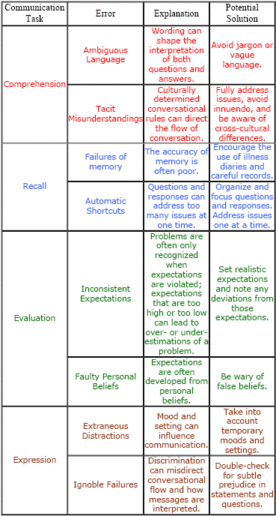The WAGER Vol. 7(21) – Clinical Judgment: Eight Communication Error Traps
There is a clear need for well developed treatment for pathological gambling. Interestingly, non-specific or common factors such as client attributes, expectancies, and the nature of the treatment provider-patient relationship, account for a considerable amount of treatment outcome (Hubble, Duncan, & Miller, 1999). For example, treatment providers rely heavily on their patients’ self-reports to evaluate subjective phenomena, such as pain intensity and mood. A number of communication factors likely influence these reports and ultimately can affect treatment plans and progress. In Table 1, this week’s WAGER summarizes a recent review of the psychological research literature regarding common errors in treatment provider-patient communication and ways that these errors might be avoided (Redelmeier, Schull, Hux, Tu, & Ferris, 2001).
Table 1: Common treatment provider-patient communication errors and potential solutions identified by Redelmeier et al. (2001)
Portions of this table can be found in Table 1 of Redelmeier et al. (2001).
It remains unclear whether the list of errors identified by Redelmeier et al. (2001) accounts for all or even most of the major conversational hazards. More research is needed to determine the completeness of the list; research might reveal more important errors or others that Redelmeier might not have considered fundamental. Other aspects of conversation that can potentially derail meaningful communication have not been considered. For example, although treatment providers already know the importance of monitoring the verbal exchanges they make in practice, research suggests that doctors’ subtle communication style (e.g., nonverbal cues) also is extremely influential in healthcare settings (Ambady, LaPlante, Nguyen, Rosenthal, & Levinson, in press; Hall, Roter, & Rand, 1981). It is important that researchers and treatment providers begin to pay more attention to this important component of conversation as well.
The errors and potential solutions identified by Redelmeier et al. (2001) suggest the complex nature of treatment provider-patient conversation specifically and communication generally. Conversations between any two individuals can suffer from many pitfalls; however, the stakes in healthcare are sufficiently high to recommend increased vigilance. Researchers and treatment providers should keep in mind conversational treatment error traps as they develop treatment opportunities for pathological gambling.
Comments on this article can be addressed to Debi LaPlante.
References
Ambady, N., LaPlante, D., Nguyen, T., Rosenthal, R., & Levinson, W. (in press). Surgeon’s tone of voice: A clue to malpractice history. Surgery.
Hall, J. A., Roter, D. L., & Rand, C. S. (1981). Communication of affect between patient and physician. Journal of Health & Social Behavior, 22(1), 18-30.
Hubble, M. L., Duncan, B. L., & Miller, S. D. (1999). The heart & soul of change: what works in therapy. Washington, DC: American Psychological Association.
Redelmeier, D. A., Schull, M. J., Hux, J. E., Tu, J. V., & Ferris, L. E. (2001). Problems for clinical judgment: 1. Eliciting an insightful history of present illness. Canadian Medical Association Journal, 164(5), 647-651.
